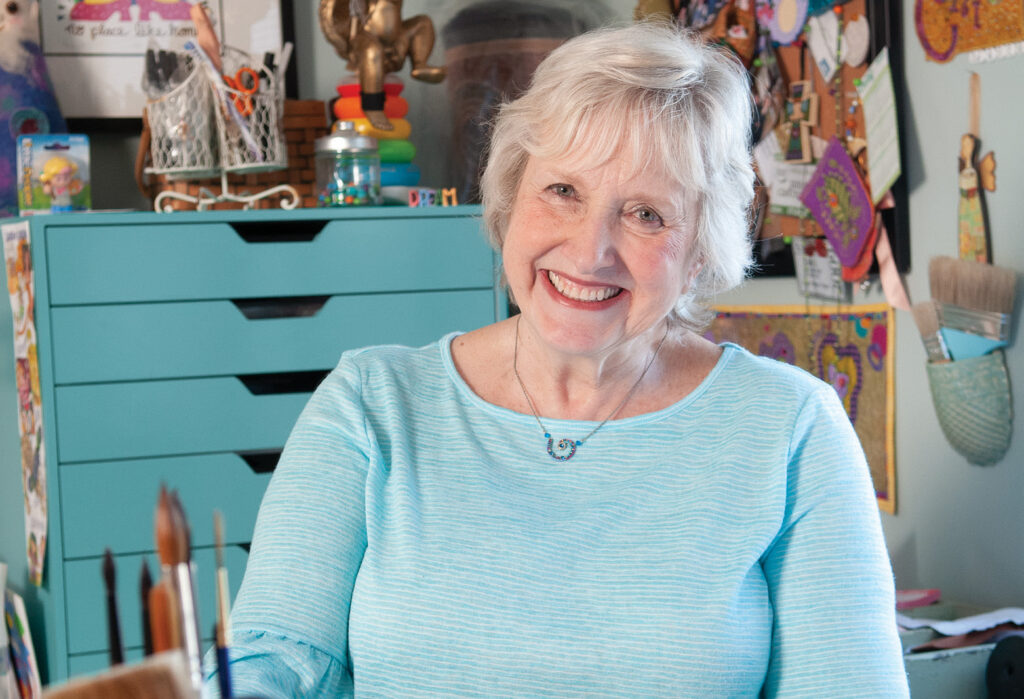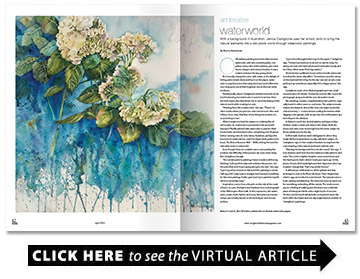Waterworld
Janice Castiglione uses her artistic skills to bring the natural elements into a storybook world through watercolor paintings
BY Emory Rakestraw

Our earliest painting memories often involve watercolor, with sets containing blue, red, yellow, every color of the rainbow, plus a few sheets of paper and various brushes. It was a creative entrance for any young mind.
Be it messily mixing the colors with water, or the delight of letting paint stream down and burst on the paper, watercolor is a joyful process that many don’t put much effort into once they grow out of their beginner sets or discover other mediums.
Paradoxically, Janice Castiglione’s earliest memories of art involve drawing, but watercolor is now her true love. Here, she finds expression that allows her to voice the beauty of the natural world while creating her own.
“Nothing flows like a watercolor,” she says. “There’s no other media where you put one color next to each other and it flows. I love color, that flow of one thing into another, it’s very exciting to me.”
While it might not hold the stature or celebrity like oil and acrylics do, watercolor is prominent in the art world. Georgia O’Keeffe painted with watercolor to practice fluid brushstrokes and dominant color, completing over 50 pieces before moving onto oil. John James Audubon, perhaps the best-known watercolorist, used it to depict field guides in his book, The Birds of America (1827 – 1839), setting the trend for naturalist works in watercolor.
Even though there are notable names surrounding the medium, the difficulty of the process can scare some away. Not Castiglione, though.
“At a certain point in painting, I have to make a shift in my thinking. I tell myself to relax and embrace the process. Let the paint flow and I’m just going along for the ride,” she says. “I give myself permission to fail, and if the painting is ruined, I tell myself it’s only a piece of paper but I learned something for the next painting. It takes guts but I try to paint for myself, which is not always easy.”
Inspiration comes from a bicycle on the side of the road, a flower in a pot, the lights and shadows from a photograph of the Wilmington Riverwalk. In this expression, the watercolor creates both rhythm and story. Each piece possesses unique personality based on the techniques and chosen surface.
“I put a lot of thought before I go to the paper,” Castiglione says. “I draw it out and love to do wet on wet for a sky. I’m doing one now and I went all around it and paint my sky and let it flow. Other areas I’ll do big washes.”
She loves the cauliflower bursts achieved with watercolor as well as the classic drip affect. “Sometimes I put the canvas on the easel and let it drip, for the sky I use wet on wet, even picking it up sometimes, especially if it’s a bigger piece,” she says.
Castiglione works a lot off photographs and uses small round brushes for details. Toward the end she likes to put the photograph away and add her own decorative touch.
Her paintings contain complementing color palettes, typically based in either warm or cool tones. The subjects exude realism at a distance, almost like how one might remember a fond memory — a warm breeze rustling the bushes while digging in the garden, with an eye-line view of the plants as a bird chirps in the distance.
In Nature’s Lace II, the vertical splatter and layered blue shadow create a center and draw in the viewer. Both the leaves and stem seem to emerge from the lower subject as flower petals press to the sky.
In Riverwalk, shadows aren’t delegated to where they might fall but instead dance or play with their subject. As Castiglione says, it’s her creative freedom to stray from the exact framing of the natural world and craft her own.
“Painting the background first sets the mood,” she says. “I love shadows and I love how the shadows make patterns and color. The center is lighter, brighter, more toned down and this leads you in; that’s where I want your eye to go. In the photo, they’re all of equal light and dark value, but when I go to paint I change that. That’s my artistic license.”
A delicate yet subliminal use of the splatter and drip technique is seen in No Place Like Home. Three bright blue robin’s eggs are nestled in a tree branch. The natural scene is both calming and alarming. The branches seem to reach out for something, extending off the canvas. The work encompasses a feeling of walking past the exact nest, a delicate place of beauty and birth with a slight touch of concern. Yet this colorful world still provides a storybook sense the birds will in fact hatch and one day maybe fly into another of Castiglione’s paintings.
When looking at her current work one might not realize she spent most of her professional career as an illustrator, although creating characters and worlds is still very much a part of her process.
After receiving a degree in illustration and graphic design from Empire State College, she took on freelance roles including creating coloring books for Random House, postcards for American Greetings, and children’s book illustrations for Modern Publishing. At Fisher- Price, she worked on the Briarberry Collection and later created hundreds of the Little People figurines, sketching the initial characters that were then sent to a sculptor.
Fewer than 10 percent of art graduates end up making a living in their major. But for Castiglione, a single mother of four, it wasn’t a matter of if but how.
“I couldn’t do anything else; I knew it in my heart,” she says. “There were times I had to do other things but that’s always where my love was, and I ended up going back to it.”
After retiring from Fisher-Price, she got back into watercolor. She does commissions here and there but says she paints what she would want to hang in her home. Illustration is still very much a part of her process. Each painting begins with a drawing utilizing graphite pencils that then dissolves when the paint is applied.
She currently teaches a virtual watercolor class at Cameron Art Museum and recently won Wilmington Art Association’s spring show poster contest for her piece Cactus Rose. The painting was created on Yupo, a nonporous paper that allows for brighter palettes than conventional watercolor paper, which Castiglione has enjoyed working with.
Today, watercolor possesses an ethereal sense. Castiglione notes the trend is moving to hyper-realistic paintings, yet she wants to remain true to herself in creating what makes her happy. Much like how her pieces arise from a simple moment of bliss or thing of beauty, that is how she also interprets creation — a joyous passion that brings happiness from the process to the paper.

Janice was an outstanding artist utilizing oils many years ago. As time has passed, I have witnessed Janice grow in talent and confidence in her craft. I am fortunate enough to own a number of originals painted by Janice. They are real treasures not only because of her immense talent but because of the depth of her love of painting, reflected in each brush stroke.
Kudos to the writer of this wonderful piece. You’ve made your subject come alive just as Janice does with each of her creations.
Thank you,